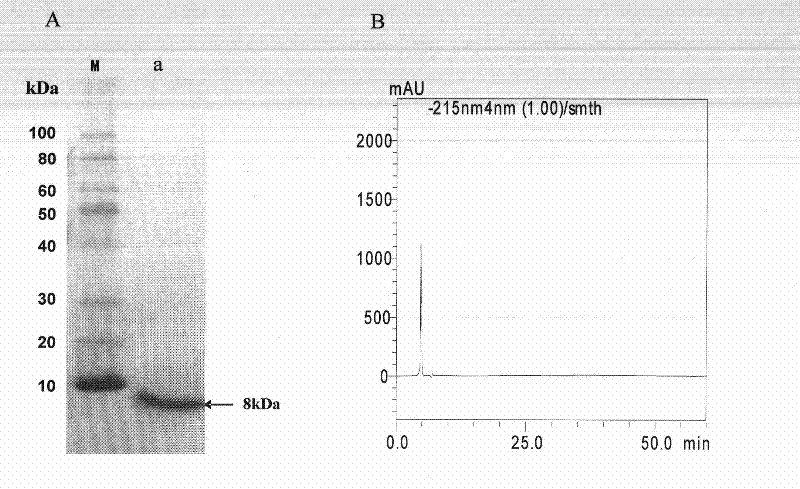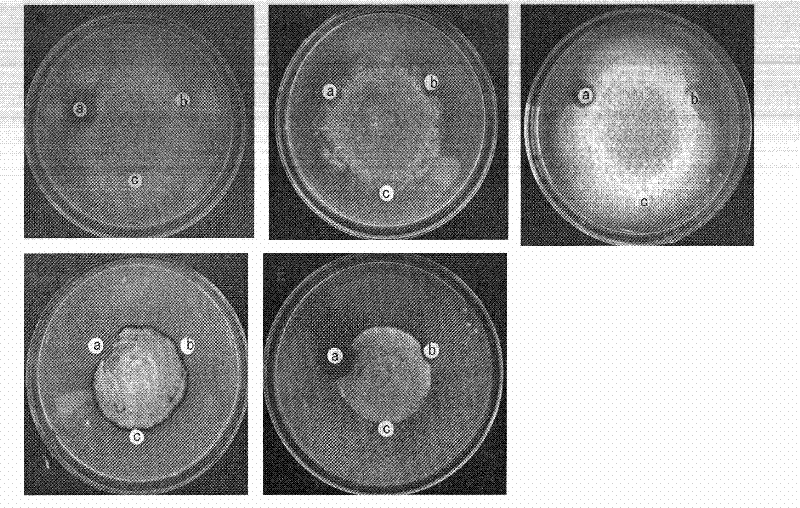A kind of camel velvet transfer protein and its preparation method and application
A technology of transferring protein and camel canopy, applied in the direction of peptide preparation method, botanical equipment and method, application, etc., to achieve the effect of inhibiting HIV-1 reverse transcriptase activity
- Summary
- Abstract
- Description
- Claims
- Application Information
AI Technical Summary
Problems solved by technology
Method used
Image
Examples
Embodiment 1
[0035] Embodiment 1: Preparation of camel velvet transfer protein PHP
[0036] (1) Crude product preparation: use camel cape seeds as materials, crush them into powder, add 0.02mol / L PBS phosphate buffer solution with pH 7.2, stir and extract overnight at 4°C, collect supernatant after low-temperature centrifugation, and use Slowly add ammonium sulfate to the supernatant to adjust the saturation to 50%, let it stand at 4°C for 4 hours, collect the supernatant by centrifugation, and discard the precipitate. Continue to slowly add ammonium sulfate to the supernatant to adjust the saturation to 70%. After standing at 4°C for 4 hours, the precipitate is collected by centrifugation, dissolved in a small amount of phosphate buffer, dialyzed to remove salt, and freeze-dried to obtain crude protein;
[0037] (2) Separation and purification by cation exchange chromatography: Use Resource S cation exchange column to perform chromatography on the crude protein obtained in the first step,...
Embodiment 2
[0040] Example 2: Research on some physicochemical properties of camel velvet transfer protein
[0041] (1) Purity and molecular weight detection
[0042] The PHP protein obtained in Example 1 is measured by Tricine-SDS-PAGE electrophoresis (gel concentration 12%), and the experimental results are as attached figure 1 As shown in panel A, the molecular weight of the subunit of the PHP protein is about 8 kDa. Adopting model is that C18ZORBAX ODS reversed-phase liquid chromatography column (Agilent) carries out high performance liquid chromatography (HPLC) identification protein PHP purity, and sample purity result shows that PHP sample purity is higher than 95% (attachment figure 1 Middle B panel). The molecular weight of PHP protein in camel camel was detected by high-performance liquid chromatography (HPLC) with model TSK-G4000 PWxl. The column temperature was 25°C, the detection wavelength was 280nm, the mobile phase was 0.05mol / LPBS (pH7.2), the solvent was 0.05mol / L PBS...
Embodiment 3
[0051] Example 3: Inhibitory effect of camel velvet transfer protein PHP on fungi
[0052] Inoculate five plant pathogenic fungi that can cause fruit rot and grain mildew, such as Rhizopus stuolonifer, Penicillium italicum, Alternaria alternata, Magnaporthe grisea and Penicillium degitatum On potato culture medium, cultivate for 48 hours at 28°C for activation to obtain activated new strains. Take 1 mL of sterile distilled water to wash the surface of the culture medium to make the fungal spores fall off and make a bacterial suspension. Preparation of bacteria-containing plates: Pour 20 mL of medium that has been autoclaved and cooled to 50°C-60°C into a plate with a diameter of 10 cm. After cooling, absorb 200 μL of bacterial suspension and drop it onto the center of the plate to make a plate containing bacteria. . When the diameter of the round surface of the mycelia spreading outward is about 2-3cm, place a sterilized filter paper sheet with a diameter of 6mm at a distanc...
PUM
| Property | Measurement | Unit |
|---|---|---|
| Half inhibitory concentration | aaaaa | aaaaa |
Abstract
Description
Claims
Application Information
 Login to View More
Login to View More - R&D
- Intellectual Property
- Life Sciences
- Materials
- Tech Scout
- Unparalleled Data Quality
- Higher Quality Content
- 60% Fewer Hallucinations
Browse by: Latest US Patents, China's latest patents, Technical Efficacy Thesaurus, Application Domain, Technology Topic, Popular Technical Reports.
© 2025 PatSnap. All rights reserved.Legal|Privacy policy|Modern Slavery Act Transparency Statement|Sitemap|About US| Contact US: help@patsnap.com



